Climate Change and Its Attribution in Three Gorges Reservoir Area, China
Abstract
1. Introduction
2. Materials and Methods
2.1. Study Area
2.2. Data
2.3. Method
2.3.1. Data Processing
2.3.2. Climate Trend Slope
2.3.3. Abrupt Climate Detection
2.3.4. OMR Method and Correlation Analysis
3. Results
3.1. Dissection of Annual Observed Meteorological Factors Variability
3.2. Climate Changes Associated with Environmental Climate Changes
3.3. Climate Changes Associated with Land Use/Cover Change
4. Discussion
4.1. Climate Change of the Three Gorges Reservoir Area
4.2. Comparison of the Impact Factors on Climate Changes
4.2.1. Temperature Change Analysis
4.2.2. RH Change Analysis
4.2.3. FD Change Analysis
4.3. Summary
4.4. Uncertainties and Limitations
5. Conclusions
Author Contributions
Funding
Acknowledgments
Conflicts of Interest
Abbreviations
References
- Flögl, W. The History of the World Register of Dams; International Commission on Large Dams (ICOLD): Paris, France, 2011; Available online: https://www.icold-cigb.org/userfiles/files/CIGB/History_of_the_WRD.pdf (accessed on 19 December 2017).
- Zarfl, C.; Lumsdon, A.E.; Berlekamp, J.; Tydecks, L.; Tockner, K. A global boom in hydropower dam construction. Aquat. Sci. 2015, 77, 161–170. [Google Scholar] [CrossRef]
- Singh, Y.; Bhat, G.M.; Sharma, V.; Pandita, S.K.; Thakur, K.K. Reservoir induced landslide at Assar, Jammu and Kashmir: A case study. J. Geol. Soc. India 2012, 80, 435–439. [Google Scholar] [CrossRef]
- Zou, X.K.; Gao, H. Analysis of Severe Drought and Heat Wave over the Sichuan Basin in the Summer of 2006. Adv. Clim. Chang. Res. 2007, 3, 149–157. (In Chinese) [Google Scholar]
- Woldemichael, A.T.; Hossain, F.; Pielke, R. Impacts of postdam land use/land cover changes on modification of extreme precipitation in contrasting hydroclimate and terrain features. J. Hydrometeorol. 2014, 15, 777–800. [Google Scholar] [CrossRef]
- Haberlie, A.M.; Ashley, W.S.; Fultz, A.J.; Eagan, S.M. The effect of reservoirs on the climatology of warm-season thunderstorms in Southeast Texas, USA. Int. J. Clim. 2016, 36, 1808–1820. [Google Scholar] [CrossRef]
- Celebi, M.; Keskin, A.H. The possible impact of Ermenek Dam on regional climate and socio-economic structure. Int. J. Agric. Environ. Res. 2016, 2, 1613–1627. [Google Scholar]
- Güner Bacanlı, Ü.; Tuğrul, A.T. A climate impact of dam lake and Recep Yazicioglu Gokpinar dam lake sample. Pamukkale Univ. J. Eng. Sci. 2016, 22, 154–159. [Google Scholar] [CrossRef]
- Miller, N.L.; Jin, J.; Tsang, C.-F. Local climate sensitivity of the Three Gorges Dam. Geophys. Res. Lett. 2005, 32, L16704. [Google Scholar] [CrossRef]
- Woldemichael, A.T.; Hossain, F.; Pielke, R. Evaluation of surface properties and atmospheric disturbances caused by post-dam alterations of land-use/land-cover. Hydrol. Earth. Syst. Sci. Discuss. 2014, 11, 5037–5075. [Google Scholar] [CrossRef]
- Correia, M.F.; da Silva Dias, M.A.F.; da Silva Aragão, M.R. Soil occupation and atmospheric variations over Sobradinho Lake area. Part one: An observational analysis. Meteorol. Atmos. Phys. 2006, 94, 103–113. [Google Scholar] [CrossRef]
- Degu, A.M.; Hossain, F.; Niyogi, D.; Pielke, R.; Shepherd, J.M.; Voisin, N.; Chronis, T. The influence of large dams on surrounding climate and precipitation patterns. Geophys. Res. Lett. 2011, 38, L04405. [Google Scholar] [CrossRef]
- Eymen, A.; Köylü, Ü. Seasonal trend analysis and ARIMA modeling of relative humidity and wind speed time series around Yamula Dam. Meteorol. Atmos. Phys. 2018, 131, 601–612. [Google Scholar] [CrossRef]
- Wu, L.; Zhang, Q.; Jiang, Z. Three Gorges Dam affects regional precipitation. Geophys. Res. Lett. 2006, 33, L13806. [Google Scholar] [CrossRef]
- Hu, C.; Wang, Y.; Wang, W.; Liu, S.; Piao, M.; Xiao, W.; Lee, X. Trends in evaporation of a large subtropical lake. Theor. Appl. Climatol. 2017, 129, 159–170. [Google Scholar] [CrossRef]
- Tanny, J.; Cohen, S.; Berger, D.; Teltch, B.; Mekhmandarov, Y.; Bahar, M.; Katul, G.G.; Assouline, S. Evaporation from a reservoir with fluctuating water level: Correcting for limited fetch. J. Hydrol. 2011, 404, 146–156. [Google Scholar] [CrossRef]
- Wu, J.; Gao, X.; Giorgi, F.; Chen, Z.; Yu, D. Climate effects of the Three Gorges Reservoir as simulated by a high resolution double nested regional climate model. Quat. Int. 2012, 282, 27–36. [Google Scholar] [CrossRef]
- Savéan, M.; François, D.; Chevallier, P.; Wagnon, P. Water budget on the Dudh Koshi River (Nepal): Uncertainties on precipitation. J. Hydrol. 2015, 531, 850–862. [Google Scholar] [CrossRef]
- Yigzaw, W.; Hossain, F.; Kalyanapu, A. Impact of Artificial Reservoir Size and Land Use/Land Cover Patterns on Probable Maximum Precipitation and Flood: Case of Folsom Dam on the American River. J. Hydrol. Eng. 2013, 18, 1180–1190. [Google Scholar] [CrossRef]
- Zhao, F.; Deng, H.; Zhao, X.Y. Rainfall regime in three Gorges area in China and the control factors. Int. J. Clim. 2010, 30, 1396–1406. [Google Scholar] [CrossRef]
- Xu, X.B.; Tan, Y.; Yang, G.S. Environmental impact assessments of the Three Gorges Project in China: Issues and interventions. Earth-Sci. Rev. 2013, 124, 115–125. [Google Scholar] [CrossRef]
- Zhang, Y.; Peng, C.H.; Li, W.Z.; Tian, L.X.; Zhu, Q.; Chen, H.; Fang, X.Q.; Zhang, G.L.; Liu, G.B.; Mu, X.M.; et al. Multiple afforestation programs accelerate the greenness in the ‘Three North’ region of China from 1982 to 2013. Ecol. Indic. 2015, 61, 404–412. [Google Scholar] [CrossRef]
- Zhao, F.Z.; Sun, J.; Ren, C.J.; Kang, D.; Deng, J.; Han, X.H.; Yang, G.H.; Feng, Y.Z.; Ren, G.X. Land use change influences soil C, N, and P stoichiometry under ‘Grain-to-Green Program’ in China. Sci. Rep. 2015, 5, 10195. [Google Scholar] [CrossRef]
- Li, Y.; Gao, Y.-H.; Chen, X.-Y.; Du, Q. The impact of the land use change associated with the Three Gorges Dam on regional climate change. J. Nanjin Univ. 2011, 47, 330–338. (In Chinese) [Google Scholar]
- Kalnay, E.; Cai, M. Impact of urbanization and land-use change on climate. Nature 2003, 423, 528–531. [Google Scholar] [CrossRef] [PubMed]
- Shen, X.; Liu, B.; Lu, X. Effects of land use/land cover on diurnal temperature range in the temperate grassland region of China. Sci. Total Environ. 2017, 575, 1211–1218. [Google Scholar] [CrossRef]
- Wu, J.; Zha, J.; Zhao, D. Evaluating the effects of land use and cover change on the decrease of surface wind speed over China in recent 30 years using a statistical downscaling method. Clim. Dyn. 2017, 48, 131–149. [Google Scholar] [CrossRef]
- Xu, X.B.; Tan, Y.; Yang, G.S.; Li, H.P.; Su, W.Z. Impacts of China’s Three Gorges Dam Project on net primary productivity in the reservoir area. Sci. Total Environ. 2011, 409, 4656–4662. [Google Scholar] [CrossRef]
- Zhang, J.X.; Liu, Z.J.; Sun, X.X. Changing landscape in the Three Gorges Reservoir Area of Yangtze River from 1977 to 2005: Land use/land cover, vegetation cover changes estimated using multi-source satellite data. Int. J. Appl. Earth Obs. Geoinf. 2009, 11, 403–412. [Google Scholar] [CrossRef]
- Tan, Y.; Yao, F.J. Three Gorges Project: Effects of resettlement on the environment in the reservoir area and countermeasures. Popul. Environ. 2006, 27, 351–371. [Google Scholar] [CrossRef]
- Kalnay, E.; Kanamitsu, M.; Kistler, R.; Collins, W.; Deaven, D.; Gandin, L.; Iredell, M.; Saha, S.; White, G.; Woollen, J.; et al. The NCEP/NCAR 40-Year Reanalysis Project. Bull. Am. Meteorol. Soc. 1996, 77, 437–472. [Google Scholar] [CrossRef]
- Kistler, R.; Kalnay, E.; Collins, W.; Saha, S.; White, G.; Woollen, J.; Chelliah, M.; Ebisuzaki, W.; Kanamitsu, M.; Kousky, V.; et al. The NCEP–NCAR 50–Year reanalysis: Monthly means CD–ROM and documentation. Bull. Am. Meteorol. Soc. 2001, 82, 247–267. [Google Scholar] [CrossRef]
- Teng, M.J.; Zeng, L.X.; Xiao, W.F.; Huang, Z.L.; Zhou, Z.X.; Yan, Z.G.; Wang, P.C. Spatial variability of soil organic carbon in Three Gorges Reservoir area, China. Sci. Total Environ. 2017, 599, 1308–1316. [Google Scholar] [CrossRef] [PubMed]
- Huang, C.B.; Teng, M.J.; Zeng, L.X.; Zhou, Z.X.; Xiao, W.F.; Zhu, J.H.; Wang, P.C. Long-term changes of land use/cover in the Three Gorges Reservoir Area of the Yangtze River, China. Chin. J. Appl. Ecol. 2018, 29, 1585–1596. (In Chinese) [Google Scholar] [CrossRef]
- Kendall, M.G. Rank Correlation Measures; Charles Griffin: London, UK, 1975. [Google Scholar]
- Mann, H.B. Nonparametric tests against trend. Econometrica 1945, 13, 245–259. [Google Scholar] [CrossRef]
- Lozowski, E.P.; Charlton, R.B.; Nguyen, C.D.; Wilson, J.D. The Use of Cumulative Monthly Mean Temperature Anomalies in the Analysis of Local Interannual Climate Variability. J. Clim. 1989, 2, 1059–1068. [Google Scholar] [CrossRef]
- Fu, C.; Wang, Q. The definition and detection of the abrupt climatic change. Sci. Atmos. Sin. 1992, 16, 482–493. (In Chinese) [Google Scholar]
- IPCC. Annex Ⅲ: Glossary. In Climate change 2013: The Physical Science Basis, Proceedings of the Contribution of Working Group Ⅰ to the Fifth Assessment Report of the Intergovernmental Panel on Climate Change, Stockholm, Sweden, 26 September 2013; Planton, S., Stocker, T.F., Qin, D., Plattner, G.-K., Tignor, M., Allen, S.K., Boshng, J., Nauels, A., Xia, Y., Bex, V., et al., Eds.; Cambidge University Press: Cambridge, UK; New York, NY, USA, 2013. [Google Scholar]
- Williams, A.P.; Sclwartz, R.E.; lacobellis, S.; Seager, R.; Cook, B.I.; Still, C.J.; Husak, G.; Michaelsen, J. Urbanization causes increased cloud base height and decreased fog in coastal Southern California. Geophys. Res. Lett. 2015, 42, 1527–1536. [Google Scholar] [CrossRef]
- Ding, Y.; Zhang, L. Intercomparison of the time for climate abrupt change between the Tibetan Plateau and other regions in China. Chin. J. Atmos. Sci. 2008, 32, 794–805. (In Chinese) [Google Scholar]
- Huang, Z.Y.; Niu, B.; Ye, L.M.; Yao, W.L.; Wang, Y.B. An analysis of climatic characteristics of extreme fog in the region around the Three Gorges Reservoir. Resour. Environ. Yangtze Val. 2012, 21, 646–652. (In Chinese) [Google Scholar]
- Lin, D.S.; Wu, C.G.; Zhou, Z.X.; Xiao, W.F.; Wang, P.C. Trends of air temperature variations in Three Gorges Reservoir Area from 1960 to 2006. Resour. Environ. Yangtze Val. 2010, 19, 1037–1043. (In Chinese) [Google Scholar]
- Goossens, C.; Berger, A. How to Recognize an Abrupt Climatic Change? In Abrupt Climatic Change; Berger, W.H., Labeyrie, L.D., Eds.; Springer: Dordrecht, UK, 1987; pp. 31–45. [Google Scholar] [CrossRef]
- Maasch, K.A. Statistical detection of the mid-Pleistocene transition. Clim. Dyn. 1987, 2, 133–143. [Google Scholar] [CrossRef]
- Bonan, G.B. Forests and climate change: Forcings, feedbacks, and the climate benefits of forests. Science 2008, 320, 1444–1449. [Google Scholar] [CrossRef] [PubMed]
- Silvério, D.V.; Brando, P.M.; Macedo, M.N.; Beck, P.S.A.; Bustamante, M.; Coe, M.T. Agricultural expansion dominates climate changes in southeastern Amazonia: The overlooked non-GHG forcing. Environ. Res. Lett. 2015, 10, 104015. [Google Scholar] [CrossRef]
- van den Bergh, T.; Körner, C.; Hiltbrunner, E. Alnus shrub expansion increases evapotranspiration in the Swiss Alps. Reg. Environ. Chang. 2018, 18, 1375–1385. [Google Scholar] [CrossRef]
- Li, L.; Chan, P.W.; Wang, D.; Tan, M. Rapid urbanization effect on local climate: Intercomparison of climate trends in Shenzhen and Hong Kong, 1968–2013. Clim. Res. 2015, 63, 145–155. [Google Scholar] [CrossRef]
- Naudts, K.; Chen, Y.Y.; MeGrath, M.J.; Ryder, J.; Valade, A.; Otto, J.; Luyssaert, S. Europe’s forest management did not mitigate climate warming. Science 2016, 351, 597–600. [Google Scholar] [CrossRef]
- Brovkin, V.; Boysen, L.; Arora, V.K.; Boisier, J.P.; Cadule, P.; Chini, L.; Claussen, M.; Friedlingstein, P.; Gayler, V.; van den Hurk, B.J.J.M.; et al. Effect of Anthropogenic Land-Use and Land-Cover Changes on Climate and Land Carbon Storage in CMIP5 Projections for the Twenty-First Century. J. Clim. 2013, 26, 6859–6881. [Google Scholar] [CrossRef]
- Wu, J.; Zha, J.; Zhao, D. Estimating the impact of the changes in land use and cover on the surface wind speed over the East China Plain during the period 1980–2011. Clim. Dyn. 2016, 46, 847–863. [Google Scholar] [CrossRef]
- Chen, X.-Y.; Song, L.-C.; Guo, Z.-F.; Gao, X.-J.; Zhang, Q. Climate change over the Three Gorge Reservoir and upper Yangtze with its possible effect. Environ. Yangtze Val. 2013, 22, 1466–1471. (In Chinese) [Google Scholar]
- World Meteorological Organization, Undated. METEOTERM. Details: Record 41362. Available online: http://wmo.multitranstms.com/MultiTransWeb/Web.mvc (accessed on 19 December 2017).
- Garcia, C.; Amengual, A.; Homar, V.; Zamora, A. Losing water in temporary streams on a Mediterranean island: Effects of climate and land-cover changes. Glob. Planet. Chang. 2017, 148, 139–152. [Google Scholar] [CrossRef]
- Avotniece, Z.; Klavins, M.; Lizuma, L. Fog climatology in Latvia. Theor. Appl. Climatol. 2014, 122, 97–109. [Google Scholar] [CrossRef]
- Tardif, R.; Rasmussen, R.M. Process-Oriented Analysis of Environmental Conditions Associated with Precipitation Fog Events in the New York City Region. J. Appl. Meteorol. Climatol. 2008, 47, 1681–1703. [Google Scholar] [CrossRef]
- Davies-Barnard, T.; Valdes, P.J.; Singarayer, J.S.; Jones, C.D. Climatic Impacts of Land-Use Change due to Crop Yield Increases and a Universal Carbon Tax from a Scenario Model *. J. Clim. 2014, 27, 1413–1424. [Google Scholar] [CrossRef]
- Hilker, T.; Lyapustin, A.I.; Tucker, C.J.; Hall, F.G.; Myneni, R.B.; Wang, Y.; Bi, J.; Mendes de Moura, Y.; Sellers, P.J. Vegetation dynamics and rainfall sensitivity of the Amazon. Proc. Nat. Acad. Sci. USA 2014, 111, 16041–16046. [Google Scholar] [CrossRef] [PubMed]
- Lindner, M.; Fitzgerald, J.B.; Zimmermann, N.E.; Reyer, C.; Delzon, S.; van der Maaten, E.; Schelhaas, M.J.; Lasch, P.; Eggers, J.; van der Maaten-Theunissen, M.; et al. Climate change and European forests: What do we know, what are the uncertainties, and what are the implications for forest management? J. Environ. Manag. 2014, 146, 69–83. [Google Scholar] [CrossRef]
- Hughes, G.O.; Thuiller, W.; Midgley, G.F.; Collins, K. Environmental change hastens the demise of the critically endangered riverine rabbit (Bunolagus monticularis). Biol. Conserv. 2008, 141, 23–34. [Google Scholar] [CrossRef]
- Ho, L.T.; Goethals, P.L.M. Opportunities and Challenges for the Sustainability of Lakes and Reservoirs in Relation to the Sustainable Development Goals (SDGs). Water 2019, 11, 1462. [Google Scholar] [CrossRef]
- Daly, C.; Conklin, D.R.; Unsworth, M.H. Local atmospheric decoupling in complex topography alters climate change impacts. Int. J. Clim. 2010, 30, 1857–1864. [Google Scholar] [CrossRef]
- Shea, J.M.; Wagnon, P.; Immerzeel, W.W.; Biron, R.; Brun, F.; Pellicciotti, F. A comparative high-altitude meteorological analysis from three catchments in the Nepalese Himalaya. Int. J. Water Resour. Dev. 2015, 31, 174–200. [Google Scholar] [CrossRef]
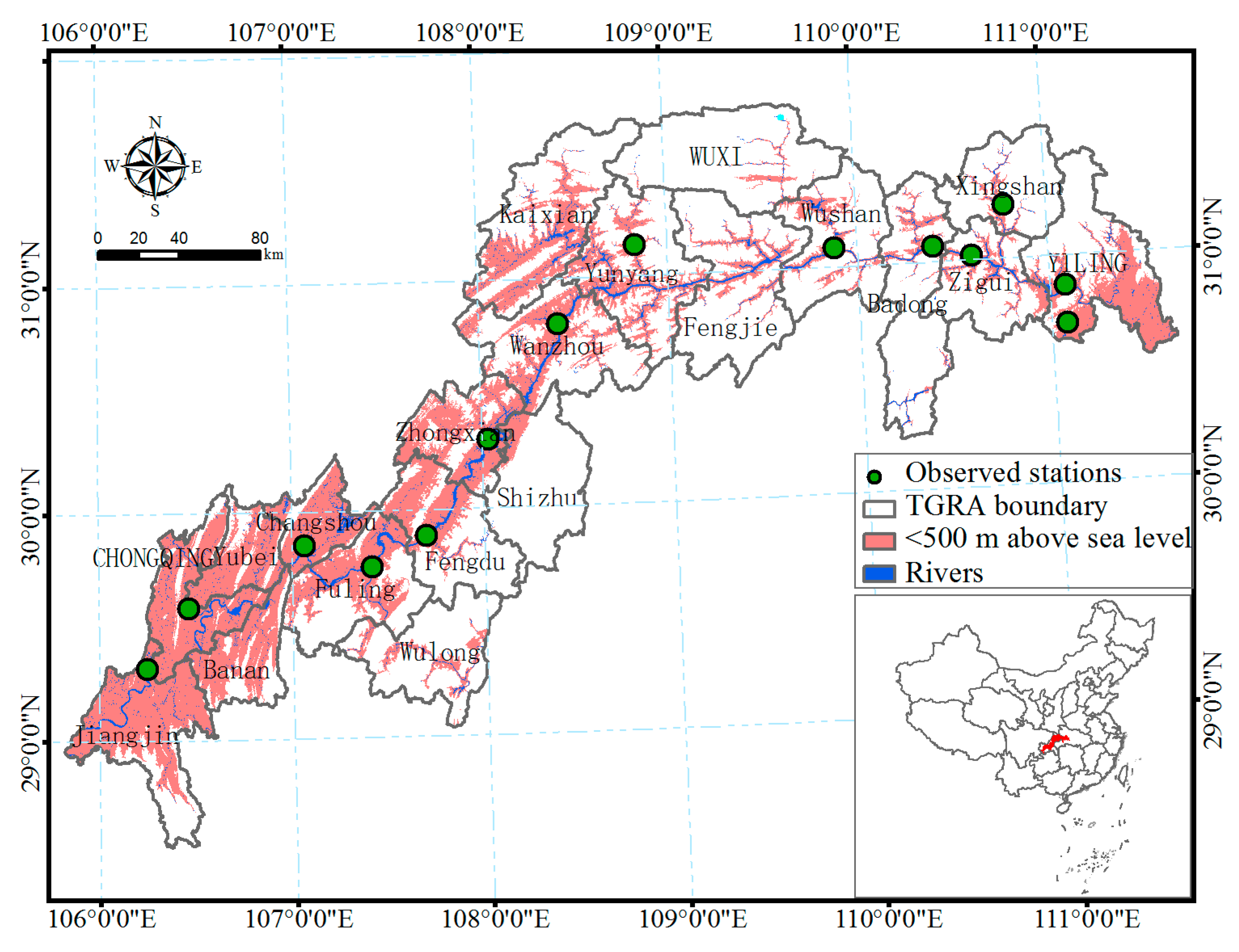
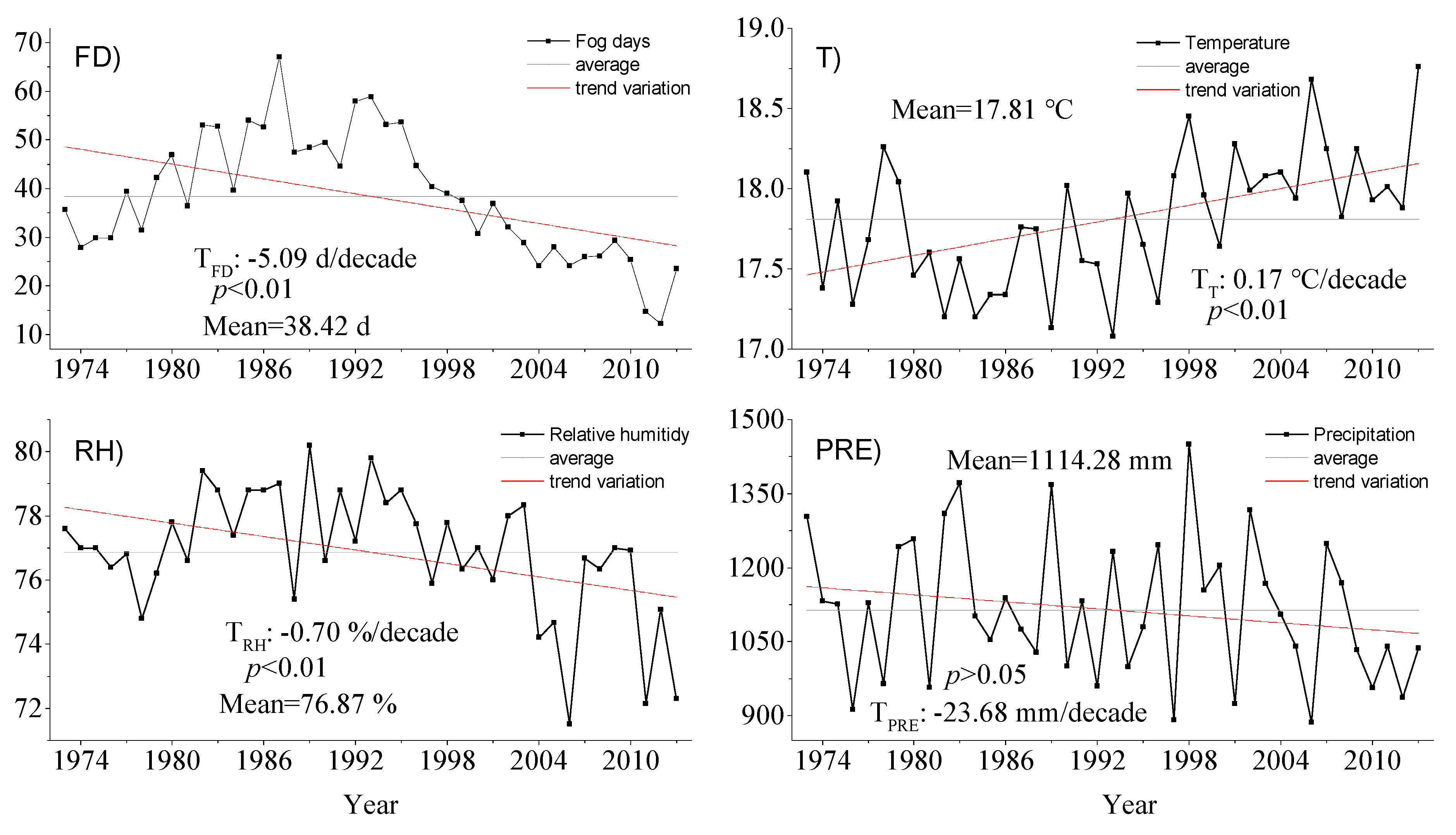

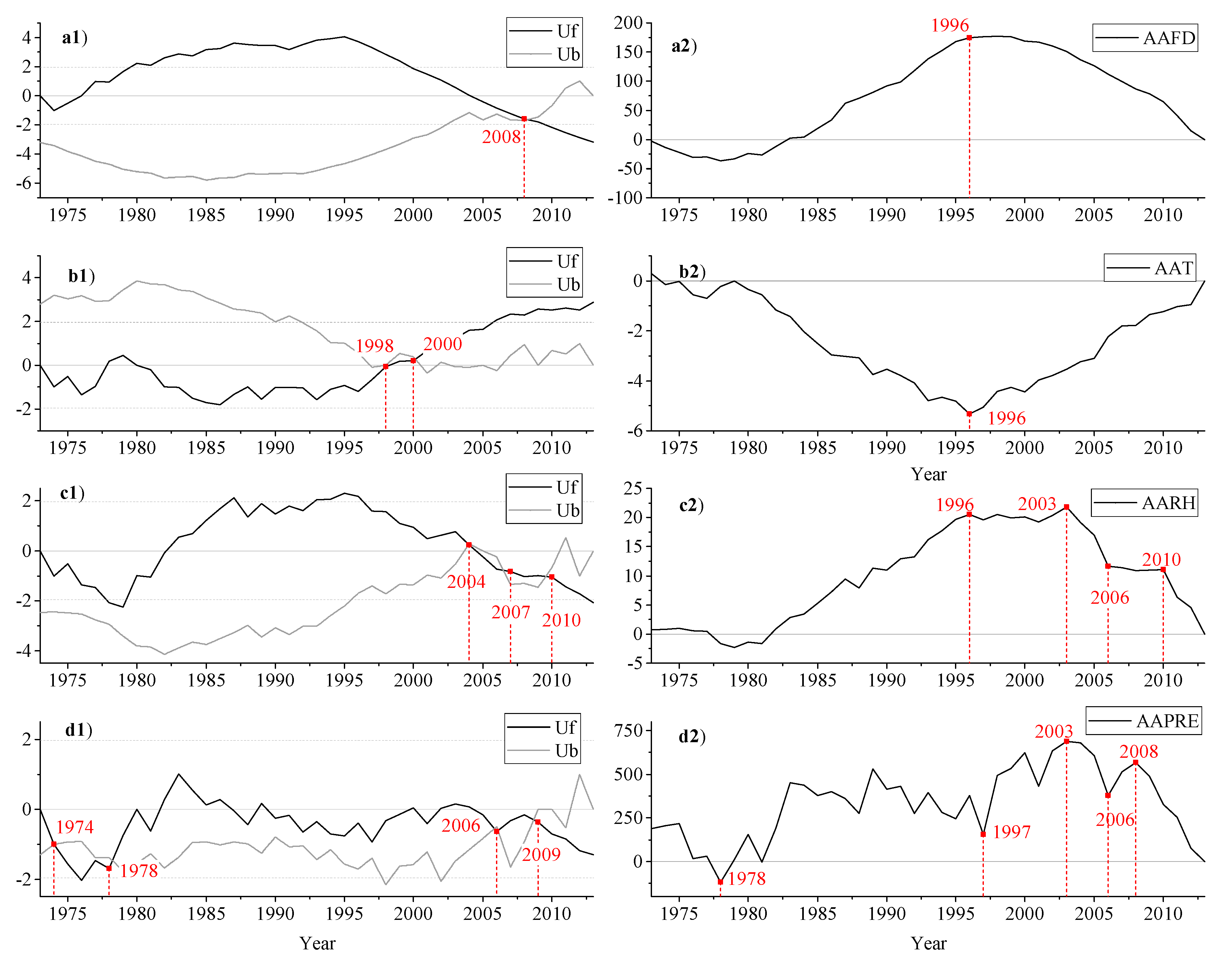
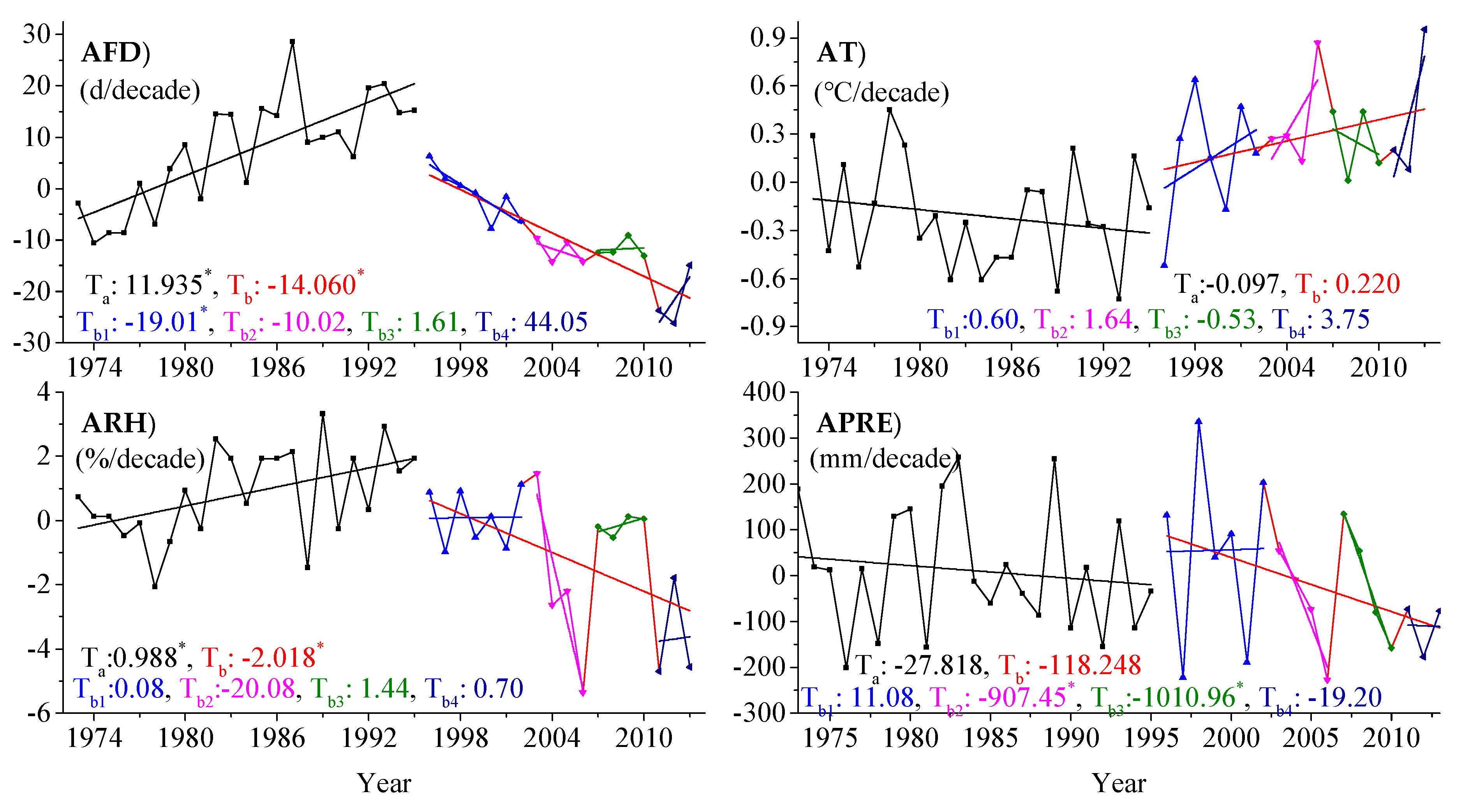
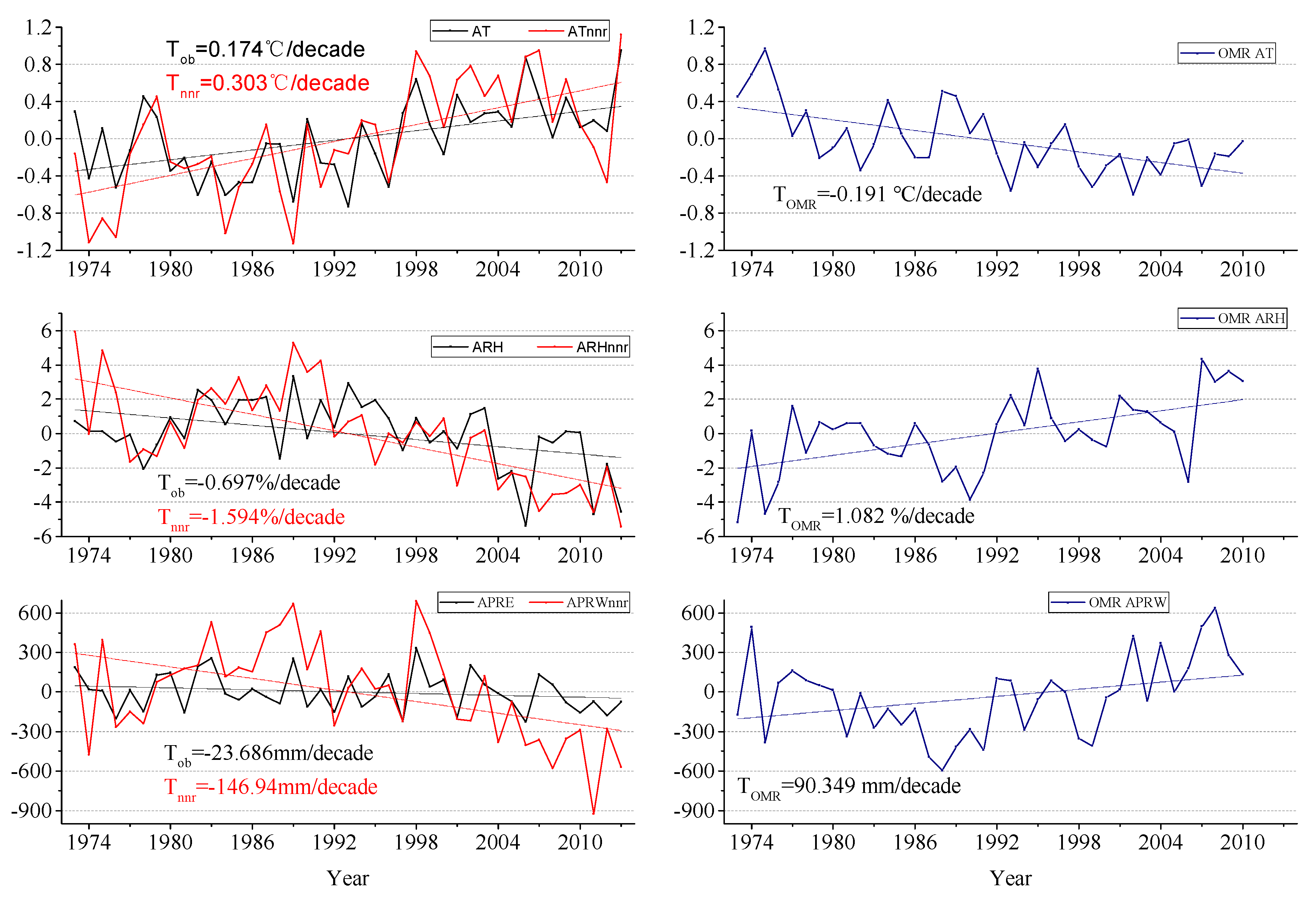

| Observed Factors | Periods | FD | T | RH | PRE | Tnnr | RHnnr | PRWnnr |
|---|---|---|---|---|---|---|---|---|
| FD | 1973–2013 | 1 | −0.518 ** | 0.705 ** | 0.233 | −0.227 | 0.557 ** | 0.620 ** |
| 1973–1989 | 1 | −0.262 | 0.665 ** | 0.325 | 0.363 | 0.180 | 0.591 * | |
| 1990–2010 | 1 | −0.596 ** | 0.600 ** | −0.034 | −0.563 ** | 0.598 ** | 0.429 | |
| T | 1973–2013 | − | 1 | −0.659 ** | −0.241 | 0.799 ** | −0.513 ** | −0.318 * |
| 1973–1989 | − | 1 | −0.604 * | −0.137 | 0.633 ** | −0.153 | −0.013 | |
| 1990–2010 | − | 1 | −0.624 ** | −0.200 | 0.842 ** | −0.395 | −0.169 | |
| RH | 1973–2013 | − | − | 1 | 0.529 ** | −0.371 * | 0.635 ** | 0.641 ** |
| 1973–1989 | − | − | 1 | 0.620 ** | −0.144 | 0.550 * | 0.508 * | |
| 1990–2010 | − | − | 1 | 0.470 * | −0.440 * | 0.476 * | 0.469 * | |
| PRE | 1973–2013 | − | − | − | 1 | 0.003 | 0.333 * | 0.476 ** |
| 1973–1989 | − | − | − | 1 | 0.103 | 0.371 | 0.475 | |
| 1990–2010 | − | − | − | 1 | 0.139 | 0.179 | 0.428 |
| Observed Factors | 1973–2013 | 1973–1989 | 1990–2010 |
|---|---|---|---|
| FD | RH>PRWnnr>RHnnr>T | RH>>PRWnnr | RH, T, RHnnr>Tnnr |
| T | Tnnr>RH>FD,RHnnr>>PRWnnr | Tnnr>>RH | Tnnr>RH>FD |
| RH | FD>T>PRWnnr>RHnnr>PRE>>Tnnr | FD>PRE>>T>>RHnnr>>PRWnnr | T>FD>RHnnr>PRE, PRWnnr>Tnnr |
| PRE | RH>PRWnnr>>RHnnr | RH | RH |
| Observed Factors | Urb | Frt | Agr | Wtr | A/F |
|---|---|---|---|---|---|
| FD | −0.890 ** | −0.907 ** | 0.892 ** | −0.746 ** | 0.940 ** |
| T | 0.511 * | 0.526 * | −0.512 * | 0.394 | −0.563 ** |
| RH | −0.491 * | −0.514 * | 0.490 * | −0.313 | 0.533 * |
| PRE | −0.059 | −0.069 | 0.070 | −0.084 | 0.004 |
| OMR Factors | Urb | Frt | Agr | Wtr | A/F |
|---|---|---|---|---|---|
| OMR T | −0.170 | −0.154 | 0.152 | −0.108 | 0.222 |
| OMR RH | 0.464 * | 0.408 | −0.441 * | 0.566 ** | −0.388 |
© 2019 by the authors. Licensee MDPI, Basel, Switzerland. This article is an open access article distributed under the terms and conditions of the Creative Commons Attribution (CC BY) license (http://creativecommons.org/licenses/by/4.0/).
Share and Cite
Zeng, Y.; Zhou, Z.; Yan, Z.; Teng, M.; Huang, C. Climate Change and Its Attribution in Three Gorges Reservoir Area, China. Sustainability 2019, 11, 7206. https://doi.org/10.3390/su11247206
Zeng Y, Zhou Z, Yan Z, Teng M, Huang C. Climate Change and Its Attribution in Three Gorges Reservoir Area, China. Sustainability. 2019; 11(24):7206. https://doi.org/10.3390/su11247206
Chicago/Turabian StyleZeng, Yixue, Zhixiang Zhou, Zhaogui Yan, Mingjun Teng, and Chunbo Huang. 2019. "Climate Change and Its Attribution in Three Gorges Reservoir Area, China" Sustainability 11, no. 24: 7206. https://doi.org/10.3390/su11247206
APA StyleZeng, Y., Zhou, Z., Yan, Z., Teng, M., & Huang, C. (2019). Climate Change and Its Attribution in Three Gorges Reservoir Area, China. Sustainability, 11(24), 7206. https://doi.org/10.3390/su11247206





